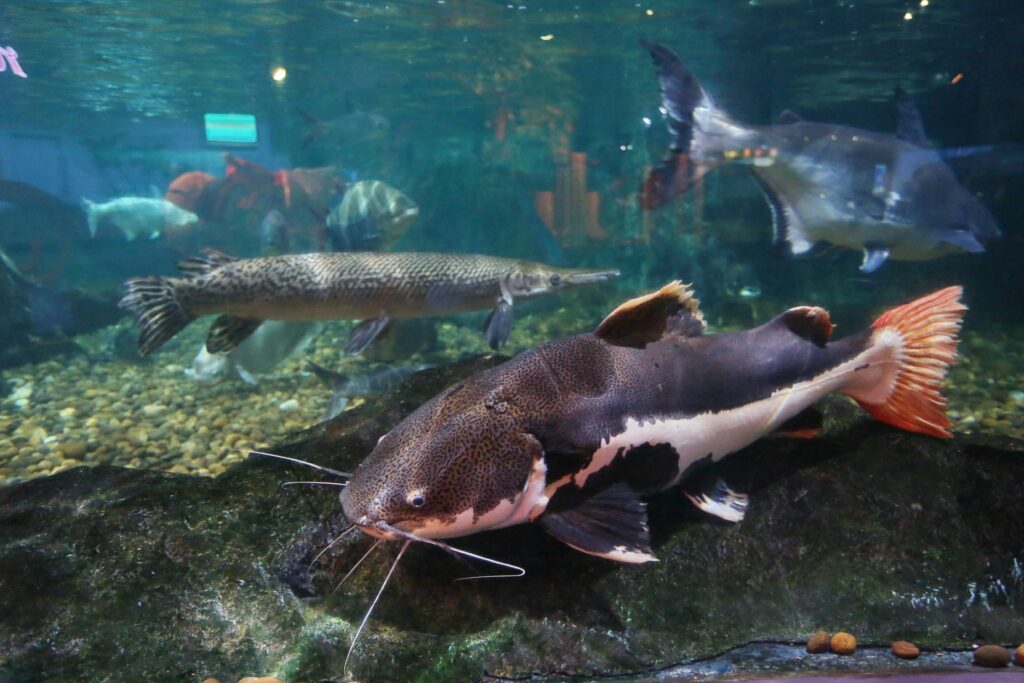Armored catfish is a prehistoric-looking fish with a flattened belly and large, sail-like dorsal fin. It has a disc-shaped sucker mouth which points down. This animal also has bony plates running the length of its back. They grows up to 20 inches and can weigh 3 pounds. Armored catfish has skin with a marbled pattern.
Armored catfish Habitats
This animal is the native to South America. Moreover, they are introduced to Florida as aquarium releases and escapes. This catfish is found in slow rivers and streams, springs, ponds and lakes. They are mostly prefers shoreline and river bank habitats.

Favorite Foods
This catfish uses sucker mouth to eat detritus (organic material pieces) . They also eat algae, bivalves and water fleas.
Critter Characteristics
They are also known as the Orinoco sailfin catfish. They have two other similar invasive species found in Florida waters. Females lay up to 2,000 eggs at one time. Males dig burrows in banks and shorelines to attract females.
Population Prevention
This is Nesting burrows may lead to erosion and bank collapse. Do not dump aquariums or exotic fish into storm drains or bodies of water to prevent more releases.
Armored catfish, known for their hardy and unique features, are fascinating creatures that can survive both in water and, briefly, on land. This remarkable adaptability raises the question: how long can armored catfish live on land?
What Are Armored Catfish?
Armored catfish belong to the family Loricariidae, native to Central and South America. They are named for the bony plates covering their bodies, offering them a form of natural armor. These fish are primarily freshwater dwellers but have evolved traits that allow them to survive under challenging conditions.
Unique Adaptations of Armored Catfish
Armored catfish own several unique features that enable them to endure environments where other fish would perish:
- Air-Breathing Capability Some species can breathe air using their modified stomachs or specialized gills. This adaptation is critical for surviving low-oxygen environments or brief excursions on land.
- Hardy Physical Structure Their armored bodies help protect them from predators and environmental hazards when they move on land.
- Mucus Secretion They produce a slimy coating that reduces water loss and provides a barrier against dehydration.
- Ability to Move on Land Using their pectoral fins, they can “walk” short distances over land, primarily to find new water sources during droughts.
How Long Can They Live on Land?
The survival time of armored catfish on land varies depending on environmental conditions. Key factors include:
- Humidity In humid environments, armored catfish can live for several hours on land, as the moisture reduces dehydration.
- Temperature Cooler temperatures slow down water loss from their bodies, extending their survival time.
- Size and Species Larger species and those with better air-breathing adaptations can survive longer.
On average, armored catfish can survive 4–8 hours on land under optimal conditions. Yet, in extremely dry and hot environments, this time may be reduced to just a couple of hours.
Why Do Armored Catfish Go on Land?
Armored catfish may leave water for several reasons:
- Drought or Drying Water Bodies They search for new habitats when their current water source dries up.
- Low Oxygen Levels During periods of low oxygen, they may surface to breathe air or move to oxygen-rich waters.
- Breeding Behavior In some cases, land movement is associated with reproduction, although this is less common.
Environmental Concerns
While their adaptability is fascinating, armored catfish have become an environmental concern in non-native areas. These fish are invasive in some parts of the world, such as Florida and Southeast Asia, where they disrupt local ecosystems.
- Ecosystem Disruption They burrow into riverbanks, causing erosion and habitat destruction for native species.
- Competition with Native Fish Their ability to thrive in harsh conditions often outcompetes native species for resources.
- Human Infrastructure Impact Burrowing activities can damage water infrastructure, leading to economic consequences.
Can Armored Catfish Survive Without Water?
Armored catfish cannot survive indefinitely without water. While they can adapt for hours on land, they need water to maintain hydration, end waste, and perform essential metabolic functions.
How to Protect Native Ecosystems
To mitigate the impact of armored catfish, conservationists recommend:
- Preventing Their Spread Avoid releasing aquarium fish into natural water bodies.
- Public Awareness Educate communities about the ecological risks of invasive species.
- Habitat Management Restore native habitats to support indigenous fish populations.
Conclusion
Armored catfish are extraordinary creatures capable of surviving on land for hours under the right conditions. Their unique adaptations make them resilient, but their invasive tendencies pose challenges to ecosystems. By understanding their biology and behavior, we can appreciate their role in nature while working to minimize their ecological impact.
Do you have more questions about these fascinating fish? Let us know! Keep with pet animal hub for more.



